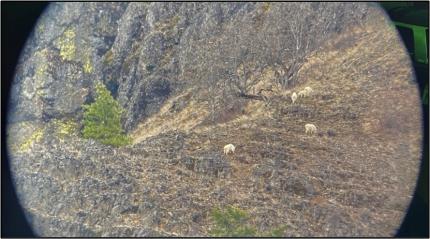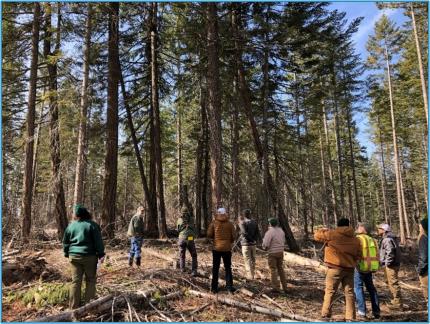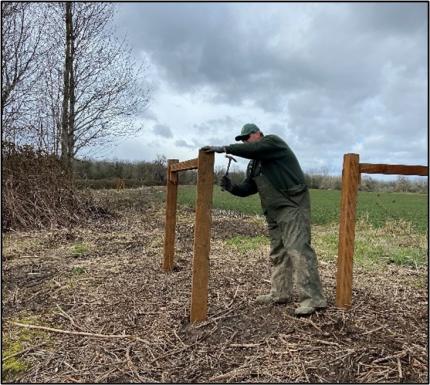Managing Wildlife Populations
Willapa Hills Elk Survey: Staff members from WDFW Regions 5 and 6 as well as Olympia joined to complete an aerial survey of the elk population in both the North and South Willapa Hills elk herd areas. The effort took place over Willapa Hills South which includes Game Management Units (GMU) 530 (Ryderwood), 506 (Willapa Hills), 681 (Bear River) and 673 (Williams Creek), as well as Willapa Hills North which includes Game Management Units 658 (North River), 660 (Minot Peak) and 672 (Fall River). The survey is conducted within a random stratified sampling design in which sub-areas of each GMU are flown, by helicopter, while three WDFW observers plus the pilot search the landscape for elk. The animals are then counted as well as classified into sexes and ages. Additionally, variables including concealing vegetation, snow cover, and habitat type are documented for each group of elk.
A total of 2,280 elk were observed by the team within 28 survey units, over the course of seven days. Following data analysis, estimates of herd population size, sub-herd population size, GMU population sizes as well as calf to cow and bull to cow ratios will be generated. These metrics will be used to evaluate the status of the Willapa Hills elk population per the guidelines outlined in the WDFW Game Management Plan and the Willapa Hills Elk Herd Plan.
Thanks to Region 2 Director Hoenes for his development of the survey method during his time as district wildlife biologist in Pacific and Gray’s Harbor counties. Thanks also to the many staff members who participated in the survey. Thanks to the personnel at the Naselle Hatchery for allowing their facility to be used as a heliport. Thanks to Region 6 Customer Service Staff Members Moe and Heath as well as Ungulate Section Manager Garrison for their respective roles of weekday and weekend flight following. Finally, thanks to Pilot Robb Grubb of Apex Helicopters for his safe and efficient piloting during the effort.





Dusky Canada Goose Surveys: Biologist Wickhem completed the final survey of District 9’s bi-monthly dusky Canada goose surveys on the Shillapoo Wildlife Area and surrounding lowlands. Dusky geese are a sub-species of Canada goose that spend summers in Alaska and migrate through and/or overwinter in the lower Columbia River area. Duskys are closed to recreational harvest due to low population levels. The purpose of the surveys is to count dusky geese observed and read alphanumeric codes on any red-collared duskys. Wildlife managers survey the geese multiple times across their primary wintering grounds and use the data to generate survival estimates. On this survey, Wickhem observed 164 dusky geese and read three collars. Other notable sightings included swans, red-tailed hawks, northern harriers, bald eagles, great blue herons, egrets, snow geese, many species of waterfowl, and a coyote successfully hunting rodents. Sandhill cranes are still hanging around in large numbers in a few interior pockets of the wildlife area. A big thanks to Wildlife Area Manager Hauswald and Assistant Wildlife Area Manager Breitenstein for all their help during this survey season.

Biologists Stephens and Holman also completed the annual dusky goose surveys, finishing the effort in Cowlitz and Wahkiakum counties. Thanks to Science Division Data Specialist Blatz for joining Holman for the final survey of the year. For more information on how and why the surveys are done, see the U.S. Fish and Wildlife Service Wild Goose Chase Storymap.


Investigating Bat Use of North Fork Lewis River Bridges: Biologist Holman joined Bat Technician Liepold and Pacificorps Wildlife Biologist Emmerson to search for evidence of bat use underneath several bridges in the North Fork Lewis River watershed. The bridges were located on Pacificorps, Department of Transportation, and U.S. Forest Service managed roadways. Evidence of use by bats was found under several bridges and one Townsend’s big-eared bat was located resting in one location.

Klickitat Wildlife Area Spring Road Survey: Biologists Wickhem and Bergh, Assistant Wildlife Area Manager Hunt, Technician Motiff, Conflict Specialist Jacobsen and Conflict Technician Kolenberg took part in the annual spring road survey to count and classify mule deer on and around the Klickitat Wildlife Area. These routes have been surveyed each spring for more than 40 years. This season, the team counted 460 deer and classified 402, the most on this survey since 2010. Despite the high number of deer observed, the crew recorded only 31 fawns for every 100 does, which ties for the lowest ratio since 1997. The 10-year average is 51 fawns for every 100 does. While disappointing, this low ratio was not surprising after the district observed the lowest ever fawn to doe ratio during our aerial surveys in December (49 to 100). For the second year in a row, the team also observed mountain goats in the upper Klickitat River canyon, which is always a survey highlight.


Western Gray Squirrel Habitat Management Field Trip: Biologist Bergh, Wildlife Area Manager Van Leuven, and Assistant Wildlife Area Manager Hunt joined a field trip organized by Habitat Program to discuss habitat management for the state-listed western gray squirrel at several spots around Klickitat County. A local forester who works for several timber companies showed the group two recent timber sales with a variable density thinning prescription. The group also visited a land trust property, a site on U.S. Forest Service Columbia River Gorge National Scenic Area lands, and the Klickitat Wildlife Area. There were good discussions on different forestry prescriptions, and it was valuable to have a diverse group of personnel including Habitat Program, Lands Division, and Diversity Division. Forest types visited by the group included mixed Douglas fir and ponderosa pine, ponderosa pine and Oregon white oak, and predominantly Oregon oak woodlands. One of the sites is also grazed by cattle and provided a snapshot of how certain grazing practices can be compatible with long-term western gray squirrel presence. Another site, dominated by ponderosa pine, has been thinned naturally by insects over the course of about 30 years and served as an example of how natural processes can alter the forest while still providing habitat for the squirrels.

Conserving Natural Landscapes
Removal of Derelict Fences on the Klickitat Wildlife Area: Master Hunter Volunteers Haskell and Rudberg came to the Klickitat Wildlife Area to assist Manager VanLeuven in removing old fences on Mar. 25. The Wildlife Area has several old fence lines that are no longer needed or maintained. These fences present unnecessary obstacles and can entangle the feet of animals and people, so it is best to remove them. The volunteers took out a fence that went through a forest management unit that is planned for this fall, removed a tangle of wires near a pond, removed a short segment of fencing and poultry netting that may have been an old hunting blind, and made a substantial start on pulling out an old three-strand barbed wire fence north of Old Headquarters. The group removed about half a mile of old fencing, a good day’s work considering the remote location of one of the project sites. On March 31 Assistant Manager Hunt led a volunteer effort with Master Hunters Haskell and Ihrig to remove more old barbed wire fencing from the Soda Springs Unit. Of the two fence lines in the project area, they removed the entire upper fence line, about 300 yards of three-strand fencing, and hauled all the coiled wire up to the ridge line. The wire cache location was recorded for future collection efforts. Manager Van Leuven and Assistant Manager Hunt enjoyed working with the energetic volunteers and greatly appreciated their help in cleaning up these derelict fences.


Cowlitz Trout Hatchery Unit Tree Planting: The Cowlitz Wildlife Area, using a local reforestation contractor, planted 5,000 Douglas fir trees into the fields on the Cowlitz Trout Hatchery Unit. The contractor acquired the trees from a local grower ensuring the seed stock was compatible with the zone and in one day planted the entire project area. Cowlitz Wildlife Area staff members prepped the site for planting by tilling strips in the fields at ten-foot intervals. The contractor planted the trees at about 540 trees to the acre. The project will return the fields, which are no longer used for agricultural purposes, to a forested environment. Some small openings will be maintained for habitat diversity and to provide forage for wildlife.

Brim Bar Access Area Management: Cowlitz Wildlife Area staff members rented a 40-foot telescopic man lift to prune trees around the perimeter of the access area. This access area on the Cowlitz Wildlife Area provides fishing access to Brim Bar on the Cowlitz River. Unfortunately, it has also been a location that has attracted residential campers due to the seclusion that the trees provided. This seclusion has also made it attractive to folks wanting to dump their household waste. Pruning the trees opened the site considerably so that traffic on adjacent Spencer Road can readily see into the access area. This should help to cut back on the unlawful activity and reduce the negative impacts to the river and riparian habitat.

Fence Replacement Continues at the Shillapoo Wildlife Area: Wildlife Area Manager Hauswald, Assistant Manager Breitenstein, and Assistant Manager Risley spent several days installing new fence posts and stretch braces at Shillapoo Wildlife Area. With completion of the project targeted for early April, it’s all hands-on-deck to finish replacing the dilapidated fencing that was removed earlier in the year and have the pasture areas ready for cattle when the ground has dried out and the grass has greened up. The new fencing will keep grazing cattle away from native tree plantings and agricultural crops but will still allow easy access to hunters and other recreational users by way of strategically placed styles that permit passage between fenced areas without having to walk along long stretches of fencing to pass through a gate.



New Affordable Housing the Mount Saint Helens Wildlife Area: With spring rapidly approaching, migrating wood ducks will soon be looking for nesting sites to nest, hatch, and raise their 2023 brood. As cavity nesters, wood ducks are very particular about site conditions when it comes to nesting, generally choosing naturally occurring cavities in standing dead trees, or “snags”, adjacent to ponds or slow-moving water. To offer the wood ducks and other cavity nesters additional nesting habitat, wildlife area staff members have constructed and installed ten new duck boxes across the Mount Saint Helens Wildlife Area. Safe from the prevailing winds, rain, and most predators, these nesting boxes offer comfortable single family living space with great views, and rates that are more than affordable…they’re free.


Providing Education and Outreach
Wind River Middle School Field Trips: Biologists Wickhem and Bergh and Technician Motiff assisted in an ecology and turtle-themed field trip for sixth and seventh grade classes from Wind River Middle School. The field trip was organized by The Friends of the Columbia River Gorge and supported by the U. S. Forest Service Scenic Area. The classes spent the day at a field site in the Gorge learning about northwestern pond turtles, turtle conservation, invasive bullfrogs, meadow plant diversity. Additionally, they got to plant native species at the site. Wickhem and Bergh gave presentations on northwestern pond turtles at the beginning of each day. The students were very excited about turtles and loved handling the educational turtle shells. Thank you to The Friends of the Columbia River Gorge for the invite and opportunity to talk turtles.

